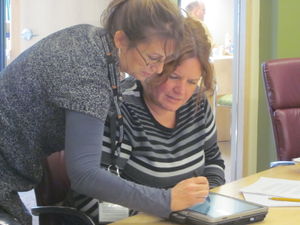Assessment
| Mathematical Journey (#Temporarytag) | |
|---|---|
| Mathematical Journey Course guide | Introduction & Aims | Development team | Video signpost | Getting started | Resources | Assessment overview | Course schedule |
| Assignments | Assignment 1 | Assignment 2 | Assignment 3 (Project & reflective journal) |
In addition to the rubrics for many of the activities, there is a general rubric for the course that us built on the outcomes (aims) for the course. The rubric is given below the aims.
As noted earlier, you will be using the Practice area of the Khan Academy materials to develop/refine your algebraic skills. Your coach will be able to review your reports to see what skills you have mastered. In adddition, you will need to place responses to worksheet questions in yor ePortfolio. These will be assessed with a rubric.
Although the journal, group project and community engagement are assessed at the end of the term, they are activities that you should be engaged in throughout the term.
By the end of this journey, learners should be able to demonstrate their ability to do the following:
|
Course Rubric
Each of the lines in the outcomes given above are tied to a row in the rubric given below.
| Attribute/Level |
Not Acceptable |
Minimally Acceptable |
Acceptable |
Exceeds |
|---|---|---|---|---|
| Toolbox |
Does not have the algebraic tools at hand to solve stated problems |
Can access tools with some prodding and then is able to apply with success toward the problem at hand |
Has tools at hand and can access them as needed to solve the problem at hand. |
Not only has a solid available toolbox of methods but also has the skills available to add to that toolbox as needed. |
| Assumptions |
Does not identifying any assumptions before addressing the problem at hand |
Identifies some assumptions, but has an incomplete list |
Identifies critical assumptions for the problem at hand |
Addresses all assumptions and thinks ahead to the implications of those assumptions for the solution of the problem |
| Model |
Model is either non-existent or so unorganized that it is nearly impossible to follow; conclusions are unsupported and often incorrect |
Model is presented with some explanation and followed through; conclusion may have a few minor flaws, but is generally acceptable |
Model is laid out clearly and followed through; good organization makes model clear; model leads to defendable conclusion |
Excellent documentation accompanies the model and it is followed through to a clearly laid-out conclusion, which is supported throughout with good mathematics |
| Articulation |
Little (if any) explanation is given regarding the mathematics used and/or incorrect interpretation is proposed. Terms are not defined. |
General steps are identified for a proposed solution, although some details are missing or unclear. Interpretation of the mathematics is generally correct. Most terms are defined. |
The problem-solving process is clearly articulated and the interpretation of the math used is correct. All terms are identified correctly. |
The whole process is explained fully in each step. All results are fully interpreted and there is a depth to the interpretation. All terminology is defined in one’s own words and demonstrates a solid comprehension of all terms and approaches. |
| Validation |
The solution is not validated. |
Some attempt is made to check the solution for validity. |
The solution is validated. |
Several approaches are used to validate the given solution. |
| Self-Assessment |
No self-assessment occurs. |
Some strengths and areas for improvement are identified. |
Good insight is added to careful identification of strengths demonstrated as well as areas to improve. |
Along with clear articulation of strengths and areas to improve, the learner demonstrates impressive insight into the whole process. |
Overview
| Description | Total marks | Weight | Due date | Aims (Objectives) Addressed | |
| |
|---|---|---|---|---|---|---|---|
| Assignment 1 story with spreadsheet (see rubric 1) |
100 | 10% | End of week 4 | 1,3,4 (See above) |
|
| |
| Skill Development documented in Khan Academy reports and through worksheet assignments |
100 | 40% | End of week 8 | 1, 4,5, 6 (See above) |
|
|
|
| Group or Individual Project (see course rubric) | 100 | 30% | End of week15 | 1, 2, 3,4, 5 (See above) |
|
| |
| Reflective Journal (see rubric 3) | 100 | 20% | End of week 15 | 4,6 (See above) |
|
|
Assessment will be based on the following (as also reflected in individual and course rubrics):
- The journal should have at least one entry per week, in which the learner identifies what strengths they have demonstrated, what areas still need improvement and any insights they have gained from their study.
- The learner will document what OERs s/he has used, a summary of topics covered and results of any assessments completed within the OER (for example, if Khan Academy is used, the learner should have registered and can therefore share results of assessments).
- The learner will work with an AVI (either individually or within a group) on a quantitative project. In this project, the learner will identify a problem and using a problem-solving methodology to develop a model to solve that problem, work toward a solution. Work on this project will be documented.
- The learner will have at least one Skype call with the AVI to discuss his/her work.
